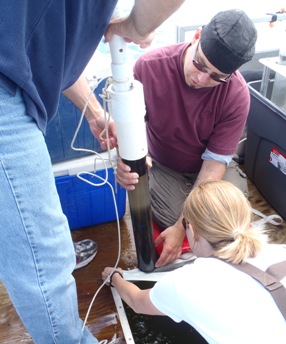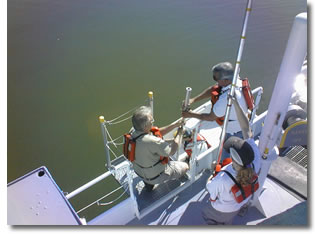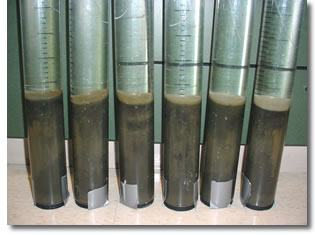Spring Lake Phosphorus Project: Pre- and Post-Alum Treatment Internal Loading Studies 2003-2016

Background
Spring Lake is a highly eutrophic lake in west Michigan that is impacted by high phosphorus levels. The excessive phosphorus and other nutrients cause algal blooms in the lake, which degrade its recreational value and ecological health.
In highly eutrophic lakes such as Spring Lake, internal loading can account for a substantial amount of the total phosphorus load.
Historically, investigations of phosphorus loads in water bodies have focused on external loading of phosphorus from the watershed. However, many studies have shown that reductions in external nutrient load do not reduce algal growth because of the counteracting release of phosphorus by sediments (i.e., internal loading).
Project Summary
The Spring Lake-Lake Board, through Progressive AE, first contracted the Steinman Lab in 2003 to study the importance of internal phosphorus loading in Spring Lake. Based on our initial findings, the community approved an alum treatment in the lake to limit internal phosphorus loading. This treatment, conducted in November 2005, was found to work very well, and has resulted in lower phosphorus concentrations and reduced algal blooms in Spring Lake.
Monitoring data in 2015 suggest that lake conditions have started to degrade, and it is possible that after 10 years, the alum treatment is starting to lose its effectiveness. As a consequence, AWRI will be measuring internal phosphorus loading in September 2016 and comparing results to previous measurements.


Through our experiments, we have:
- determined that internal loading is a significant source of phosphorus to Spring Lake (55-65% of the total load),
- found that alum was effective at reducing rates of internal loading in Spring Lake,
- identified the most effective dosing concentration for alum application,
- shown that resuspension of sediments substantially increased total phosphorus (TP) concentrations, but not total dissolved phosphorus in alum-treated sediments, and
- assessed the effectiveness and ecological effects of alum application at 8 months, 5 years, and 11 years after treatment.
Internal Loading Experiments
Experiment 1: 2003
The goals of this experiment were to determine whether: 1) internal phosphorus loading was a significant source of phosphorus to Spring Lake, and 2) an alum application would be effective at reducing internal loads.
Experiment 2: 2004
The goals of this experiment were to determine: 1) what effect different alum concentrations have on phosphorus release from the sediments, and 2) whether resuspension of alum (caused by storm events) decreases its effectiveness.
Experiment 3: 2004
The goals of this experiment were to determine:
- what effect bioturbation (mixing caused by benthic invertebrates) has on the effectiveness of alum
- whether the effect of bioturbation varies at different alum concentrations
Experiment 4: 2006
This experiment took place ~8 months after alum was applied to Spring Lake. The goals of this experiment were to determine: 1) the effectiveness of the alum application in reducing internal phosphorus loading rates in Spring Lake and 2) the ecological effects of alum in Spring Lake.
Experiment 5: 2010
The goals of this experiment were to determine the effectiveness of the alum treatment in reducing internal loading rates and the ecological effects of alum in Spring Lake 5 years following the 2005 application.
Experiment 6: 2016
The goals of this experiment are to analyze internal phosphorus loading and measure ecological effects of alum treatment in Spring Lake 11 years after the 2005 application.
Funding for this work was provided by the Spring Lake-Lake Board.
Publications:
Steinman, A.D., R. Rediske, and K.R. Reddy. 2004. The importance of internal phosphorus loading to Spring Lake, Michigan. Journal of Environmental Quality 33: 2040-2048.
Steinman, A.D., L. Nemeth, E. Nemeth, and R. Rediske. 2006. Factors influencing internal phosphorus loading in a west-Michigan, drowned river mouth lake. Journal of the North American Benthological Society 25: 304-312.
Steinman, A.D. and M. Ogdahl. 2008. Ecological effects following an alum treatment in Spring Lake, Michigan. Journal of Environmental Quality 37: 22-29.
Steinman, A.D. and M.E. Ogdahl. 2012. Macroinvertebrate response and internal phosphorus loading in a Michigan Lake following alum treatment. Journal of Environmental Quality 41: 1540-1548.
Reports:
Internal Phosphorus Loading in Spring Lake: Year 1
Internal Phosphorus Loading in Spring Lake: Year 2
Internal Phosphorus Loading in Spring Lake Eight Months Following an Alum Treatment
Internal Phosphorus Loading in Spring Lake 5 Years Following Alum Treatment
Internal Phosphorus Loading in Spring Lake 11 Years Following Alum Treatment
Project Partner:
Progressive AE
Contacts:
Al Steinman, Project Manager: steinmaa@gvsu.edu
Mike Hassett, Lead Technician: hassetmi@gvsu.edu

